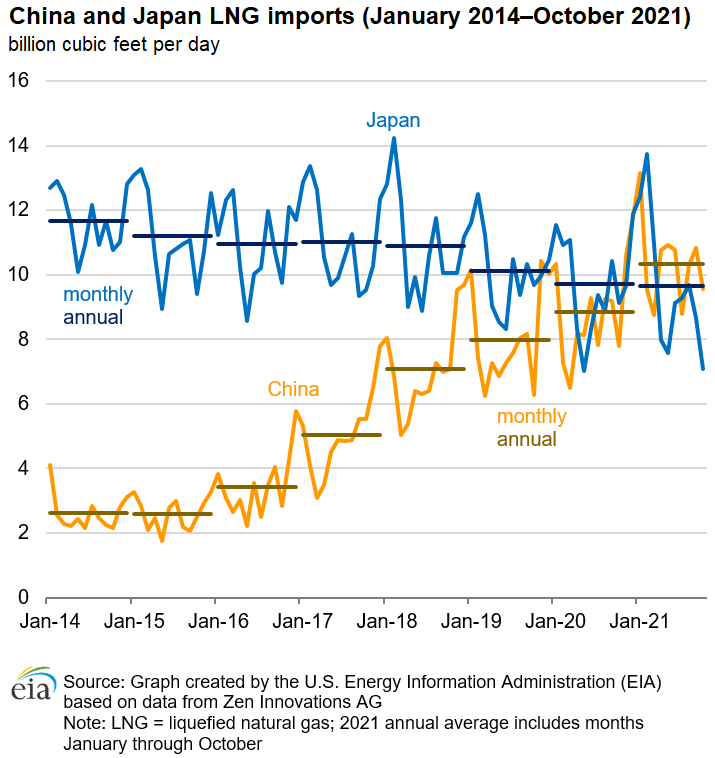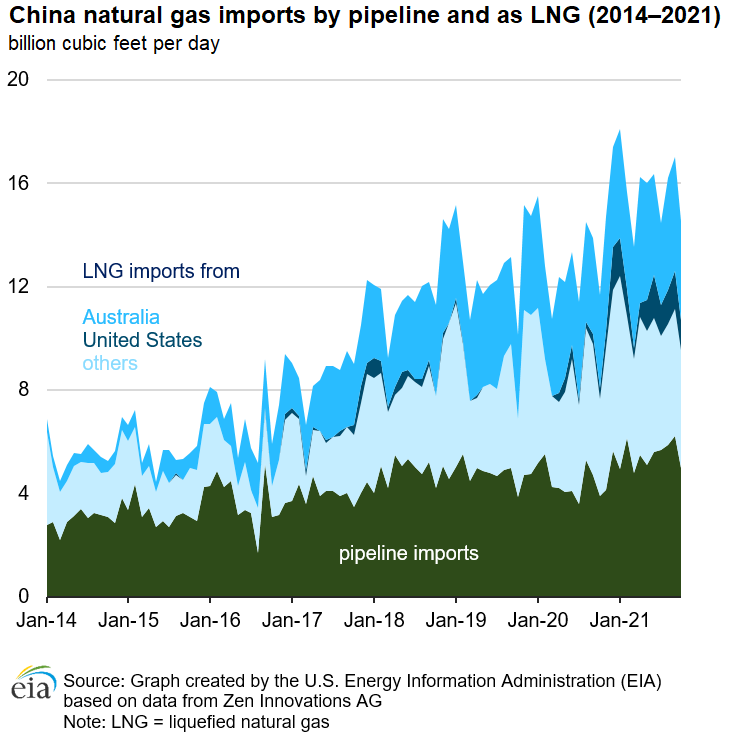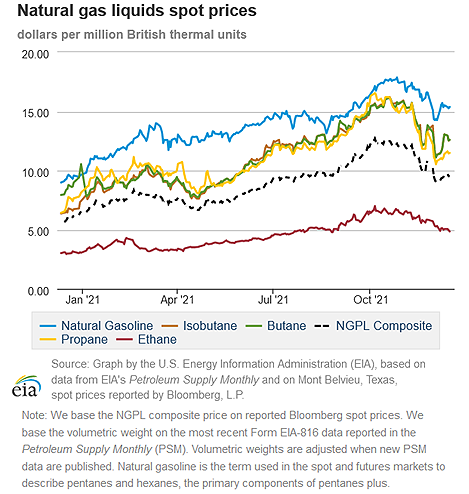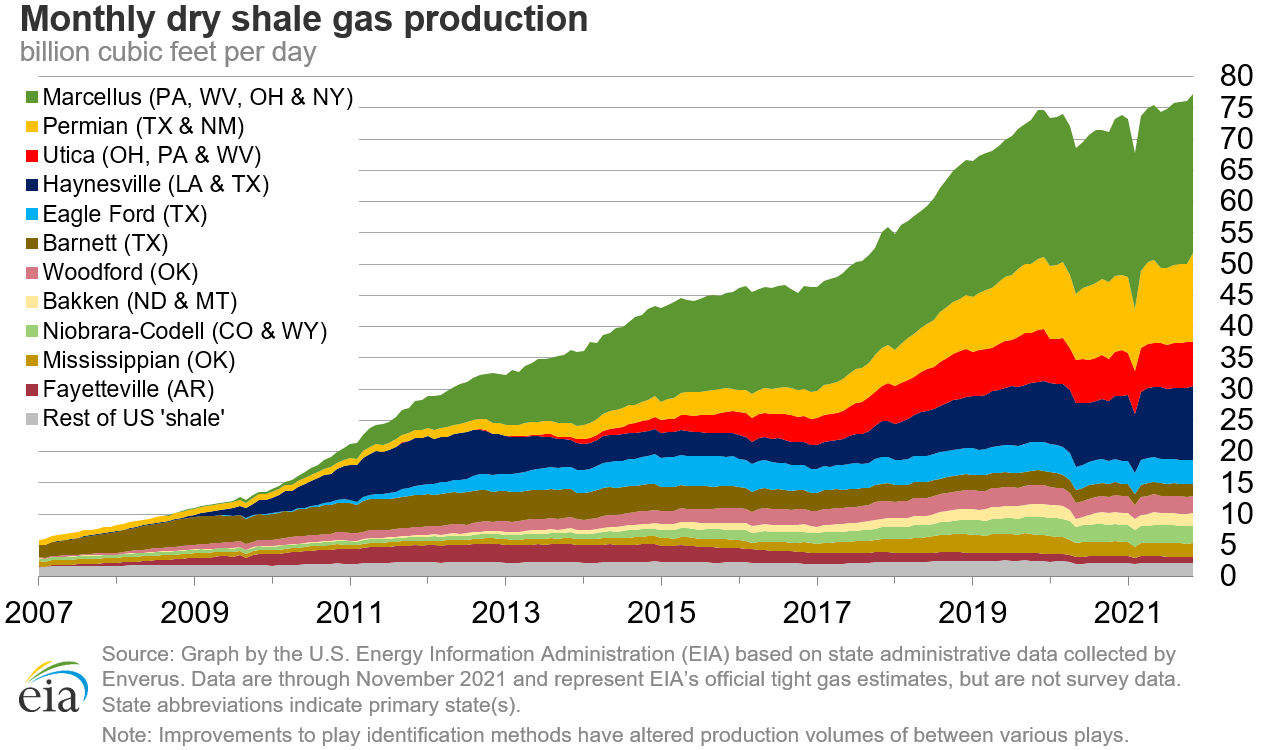In the News:
China becomes world’s largest LNG importer in the first 10 months of 2021
China’s imports of liquefied natural gas (LNG) over the first 10 months of 2021 were the world’s largest, surpassing Japan, according to data from China’s Administration of Customs and from Japan’s Ministry of Finance. Prior to 2021, Japan had been the world’s largest LNG importer for 51 years, according to historical Cedigaz data. From January through October 2021, China’s LNG imports averaged 10.3 billion cubic feet per day (Bcf/d), a 2.0 Bcf/d (24%) increase over the same period last year. Japan’s LNG imports averaged 9.6 Bcf/d over the same period.
China’s LNG imports have grown steadily every year since 2006 (when China began importing LNG), except in 2015. In 2017, China became the world’s second-largest LNG importer, surpassing South Korea. In 2018, China surpassed Japan as the world’s largest natural gas importer; combined natural gas imports by pipeline and LNG averaged 11.9 Bcf/d compared with Japan’s average LNG imports (Japan does not import natural gas by pipeline) of 10.9 Bcf/d that year.
Growth in China’s LNG imports has been supported by the rapid expansion of LNG import capacity. Between 2013 and 2020, China’s LNG import capacity more than doubled from 5.8 Bcf/d to 11.7 Bcf/d, according to the International Group of Liquefied Natural Gas Importers (GIIGNL). In 2021, China’s LNG import capacity increased further to an estimated 12.9 Bcf/d when expansions at four existing terminals were completed. By 2024, as several more projects currently under construction are completed, China’s LNG import capacity will expand by an estimated 4.0 Bcf/d, according to the International Gas Union.
Imports and domestic production of natural gas have both grown to meet China’s increasing natural gas demand, which has been primarily driven by government policies promoting coal-to-natural gas switching in an effort to reduce air pollution and meet emissions targets. Since becoming the world’s third-largest natural gas consumer in 2013 behind the United States and Russia, domestic natural gas production in China has expanded, as have natural gas pipeline and LNG imports. Between 2013 and 2020, domestic natural gas production in China nearly doubled, from 16.6 Bcf/d to 31.9 Bcf/d (a 15.3 Bcf/d increase, or 92%); natural gas imports by pipeline almost doubled from 2.6 Bcf/d to 4.4 Bcf/d (a 1.8 Bcf/d increase, or 71%); and LNG imports nearly quadrupled from 2.4 Bcf/d to 9.1 Bcf/d (a 6.7 Bcf/d increase, or 275%), according to BP’s Statistical Review of World Energy.
In 2021, China imported LNG from 23 countries. Australia has been the largest LNG supplier to China every month since April 2016. From January to October 2021:
- LNG imports from Australia averaged 4.1 Bcf/d, a 0.3 Bcf/d increase (9%) year over year, accounting for 40% of China’s total LNG imports.
- LNG from the United States, Qatar, and Malaysia each accounted for about 11% of total imports to China. Imports from each country averaged about 1.1 Bcf/d.
- LNG imports from the United States increased by 0.9 Bcf/d (320%) compared with the same period last year and ranked second behind Australia. China became the second-largest destination for U.S. LNG exports in 2021 (January through October), according to the U.S. Department of Energy’s LNG monthly reports.
- LNG imports from Qatar and Malaysia increased by 0.3 Bcf/d compared with the same period last year.
- The remaining 19 countries supplied a combined 2.8 Bcf/d (27% share) of LNG to China. LNG imports from Indonesia and Russia (the fifth- and sixth-largest suppliers) averaged 0.7 Bcf/d and 0.6 Bcf/d, respectively.
Overview:
(For the week ending Wednesday, December 15, 2021)
- Natural gas spot prices fell at most locations this report week (Wednesday, December 8 to Wednesday, December 15). The Henry Hub spot price fell from $3.79 per million British thermal units (MMBtu) last Wednesday to $3.75/MMBtu yesterday.
- International natural gas prices rose this report week. Bloomberg Finance, L.P. reports that swap prices for liquefied natural gas (LNG) cargos in East Asia for the balance of the month (December) rose to a weekly average of $35.29/MMBtu, the second-highest weekly average on record dating back to January 2020 and 23 cents above last week’s average of $35.06/MMBtu. At the Title Transfer Facility (TTF) in the Netherlands, the most liquid natural gas spot market in Europe, the day-ahead price rose for the sixth week in a row to a weekly average of $38.10/MMBtu, the highest weekly average on record dating back to September 2007 and up $6.92/MMBtu from last week’s average of $31.18/MMBtu. In the same week last year (week ending December 16, 2020), prices in East Asia and at TTF were $8.00/MMBtu and $5.81/MMBtu, respectively.
- The price of the January 2022 NYMEX contract decreased 1.3 cents, from $3.815/MMBtu last Wednesday to $3.802/MMBtu yesterday. The price of the 12-month strip averaging January 2022 through December 2022 futures contracts climbed 1.7 cents to $3.738/MMBtu. Natural gas futures prices for delivery through the end of the current heating season fell 0.5 cents to $3.744/MMBtu, but futures for delivery during the coming summer months increased by 3.0 cents to $3.671/MMBtu, further flattening the futures curve. The premium for natural gas futures for delivery during the winter months is now 7.2 cents/MMBtu above contract prices for summer delivery, down from 10.8 cents/MMBtu last week.
- The net withdrawals from working gas totaled 88 billion cubic feet (Bcf) for the week ending December 10. Working natural gas stocks totaled 3,417 Bcf, which is 9% lower than the year-ago level and 2% lower than the five-year (2016–2020) average for this week.
- The natural gas plant liquids composite price at Mont Belvieu, Texas, rose by 36 cents/MMBtu, averaging $9.57/MMBtu for the week ending December 15. Ethane prices fell 3% following a 3% drop in natural gas prices at the Houston Ship Channel. Ethylene prices decreased by 2%, narrowing the ethane to ethylene price spread for the week ending December 15. Propane prices rose 5%, compared to a 1% increase in Brent crude oil prices, narrowing the propane discount to crude oil by 24%. Normal butane and isobutane prices rose 11%. Natural gasoline prices rose 2% following Brent crude oil prices.
- According to Baker Hughes, for the week ending Tuesday, December 7, the natural gas rig count increased by 3 to 105 from the previous report week. The Eagle Ford, Haynesville, and Utica basins each gained one rig. The number of oil-directed rigs increased by 4 to 471 this week. The largest change in the oil-directed rigs was in the Permian Basin, where three rigs were added. The total rig count now stands at 576, the highest level since April 9, 2020.
Prices/Supply/Demand:
Prices along the Gulf Coast fall with lower feed gas to LNG terminals and mixed weather across the country. This report week (Wednesday, December 8 to Wednesday, December 15), the Henry Hub spot price fell 4 cents from $3.79/MMBtu last Wednesday to $3.75/MMBtu yesterday. Prices at the Henry Hub rose to a weekly high of $3.96/MMBtu on Monday, then fell 31 cents to a weekly low of $3.65/MMBtu on Tuesday, before rising again yesterday. Weather, both along the Gulf Coast and across the country, has been highly variable this week. IHS Markit estimates consumption in Southern Louisiana remained relatively steady this week, rising by less than 0.1 Bcf/d from an average of 3.5 Bcf/d last week to an average of 3.6 Bcf/d this week. Feed gas volumes to LNG export terminals in Southern Louisiana declined, however, from 6.6 Bcf/d last week to 6.2 Bcf/d this week. Dense fog along the Gulf Coast affected shipping out of major LNG terminals on Tuesday and Wednesday. Pilot Service was suspended along the Sabine-Neches Waterway, affecting traffic in and out of the Sabine Pass LNG terminal.
Midwest prices rise with expectations of cooler weather moving into the region through the rest of the week. At the Chicago Citygate, the price increased 2 cents from $3.57/MMBtu last Wednesday to $3.59/MMBtu yesterday. The price at the Chicago Citygate dropped to a weekly low of $3.39/MMBtu Tuesday as a result of warmer weather and low heating demand, but it rose yesterday in advance of cooler temperatures forecast for the region. Severe high winds swept across the Rockies and Midwest yesterday, bringing warm air from the Desert Southwest up into the Great Lakes area. Temperatures set new records across the region. National Oceanic and Atmospheric Administration (NOAA) reports temperatures in Wichita, Kansas, rose to a daily high of 77°F yesterday, 31°F above the normal high and a new record. Temperatures in the Chicago area also set new records; the daily high yesterday reached 66°F, 29°F above normal. The average daily temperature in Chicago yesterday was 58°F, 28°F above normal, resulting in 7 heating degree days (HDDs—a measure of heating demand), compared with 34 HDDs expected under a normal-weather scenario. Overall, HDDs in the Chicago area dropped, from 206 HDDs last week to 143 HDDs this week, resulting in natural gas demand in the residential and commercial sector declining in the Midcontinent by 20% from an average of 10.9 Bcf/d last week to 8.8 Bcf/d this week, according to IHS Markit. NOAA forecasts a rapid return to normal and below-normal temperatures in the next three days, with daily high temperatures in the Chicago area falling to 33°F, on par with normal temperature for this time of year, by Sunday.
California prices are mixed: Northern California prices rise in response to higher prices in supply regions, while Southern California prices decline from recent record highs. The price at PG&E Citygate in Northern California rose 6 cents, up from $5.23/MMBtu last Wednesday to $5.29/MMBtu yesterday. PG&E Citygate prices reached a weekly high of $5.85/MMBtu on Monday. Prices at the PG&E Citygate rose by less than prices in the supply regions where PG&E sources most of its gas. The price at Sumas on the Canada-Washington border and the main pricing point for the Pacific Northwest rose 46 cents from $4.83/MMBtu last Wednesday to $5.29/MMBtu yesterday. The price at Malin, Oregon, the northern delivery point into the PG&E service territory, rose 16 cents from $4.96/MMBtu last Wednesday to $5.12/MMBtu yesterday.
The price at SoCal Citygate in Southern California decreased 68 cents from $7.31/MMBtu last Wednesday to $6.63/MMBtu yesterday. Prices at SoCal Citygate reached a weekly high of $8.93/MMBtu on Monday—the highest level since early September. For most of this week, deliveries to customers in the SoCalGas service territory exceeded available capacity to deliver natural gas into the system, resulting in the system operator declaring a Low Operational Flow Order (OFO). The Low OFO order in turn resulted in the activation of withdrawal capacity at the Aliso Canyon Storage Facility (see notices re: Condition 1), which has allowed the system to balance. Southern California, along with the Desert Southwest, have some of the highest pricing points in the country as a result of continuing flow reductions on the El Paso Natural Gas (EPNG) pipeline system.
Prices in the Northeast decline as a result of persistent warmer-than-normal weather in the region and improved pipeline connectivity. At the Algonquin Citygate, which serves Boston-area consumers, the natural gas price fell $5.12 from $8.62/MMBtu last Wednesday to $3.50/MMBtu yesterday. Natural gas consumption in the Northeast declined about 6% week on week. Warm weather moved into the region, and temperatures across New England ranged from 9°F to 15°F above normal much of the week. At the Transcontinental Pipeline Zone 6 trading point for New York City, the price decreased 57 cents from $3.57/MMBtu last Wednesday to $3.00/MMBtu yesterday.
On Tuesday Enbridge, operator of the Texas Eastern Transmission pipeline system, lifted restrictions (Notice ID 115313) on flows past the Lilly compressor west of Altoona, Pennsylvania, which increased flows by more than 200 million cubic feet per day (MMcf/d). The outage at the compressor station, which began on December 5 (Notice ID 115045), reduced eastbound flows by more than 200 MMcf/d, reducing deliverability into Philadelphia and the Atlantic Coast corridor.
Prices in the Appalachia production region fall in response to lower demand in the consuming regions of the Midwest and Northeast and impaired pipeline capacity. The Tennessee Zone 4 Marcellus spot price decreased 30 cents from $3.08/MMBtu last Wednesday to $2.78/MMBtu yesterday. The price at Eastern Gas South in southwest Pennsylvania fell 39 cents from $3.16/MMBtu last Wednesday to $2.77/MMBtu yesterday. Natural gas consumption in the Appalachia region was down 9% from the previous report week. Maintenance on Rockies Express Pipeline (REX) (Notice ID 9271) reduced westbound flows on two segments of the pipeline through Ohio. As a result of maintenance on the Hamilton compressor station in Warren County, Ohio, on Tuesday, capacity was limited on segment 360 to 2.2 Bcf/d, compared with design capacity of 2.7 Bcf/d. Maintenance on REX’s Washington Court House compressor station in Fayette County, Ohio, resulted in a capacity reduction to 2.6 Bcf/d on Tuesday and to 3.0 Bcf/d on Wednesday. The Washington Court House Compressor Station maintenance was completed early and segment 380 is being returned to its full operating capacity of 3.1 Bcf/d today (Notice ID 9283).
Prices in the Permian production region follow prices on the Gulf Coast. The price at the Waha Hub in West Texas, which is located near Permian Basin production activities, fell 6 cents this report week, from $3.47/MMBtu last Wednesday to $3.41/MMBtu yesterday. The Waha Hub traded 34 cents below the Henry Hub price yesterday, compared with last Wednesday, when it traded 32 cents below the Henry Hub price.
U.S. supply of natural gas is essentially flat week over week. According to data from IHS Markit, the average total supply of natural gas was up slightly this report week from last week, increasing by 0.4% (0.4 Bcf/d) from 100.4 Bcf/d. Dry natural gas production increased by 0.5% (0.5 Bcf/d) this week from last week’s 95.4 Bcf/d. Average net imports from Canada decreased by 2.0% (0.1 Bcf/d) from last week.
U.S. natural gas consumption decreases across most sectors for the second consecutive week. Total U.S. consumption of natural gas fell for the second week in a row, by 1.4% (1.2 Bcf/d) compared with the previous report week, according to data from IHS Markit. For two consecutive weeks, natural gas consumption fell in all sectors except power generation, where consumption was relatively flat, rising less than 1% week over week. In the residential and commercial sectors, consumption declined by 2.8% (0.9 Bcf/d) as NOAA reported above-normal daytime and nighttime temperatures across most of the United States during the past week. Industrial sector consumption decreased by 1.2% (0.3 Bcf/d) week over week. Natural gas exports to Mexico fell by 0.2 Bcf/d, from 5.3 Bcf/d last week to 5.1 Bcf/d this week, and natural gas deliveries to LNG export facilities (LNG pipeline receipts) averaged 11.8 Bcf/d, 1% (0.1 Bcf/d) lower than last week.
U.S. LNG exports decreased by five vessels this week from last week. Twenty-one LNG vessels (eight from Sabine Pass, four each from Cameron, Corpus Christi and Freeport, and one from Cove Point (none from Elba Island)) with a combined LNG-carrying capacity of 80 Bcf departed the United States between December 9 and December 15, 2021, according to shipping data provided by Bloomberg Finance, L.P.
Storage:
The net withdrawals from storage totaled 88 Bcf for the week ending December 10, compared with the five-year (2016–2020) average net withdrawals of 114 Bcf and last year's net withdrawals of 118 Bcf during the same week. Working natural gas stocks totaled 3,417 Bcf, which is 64 Bcf lower than the five-year average and 326 Bcf lower than last year at this time.
According to The Desk survey of natural gas analysts, estimates of the weekly net change to working natural gas stocks ranged from net withdrawals of 77 Bcf to 99 Bcf, with a median estimate of 89 Bcf.
More storage data and analysis can be found on the Natural Gas Storage Dashboard and the Weekly Natural Gas Storage Report.
See also:
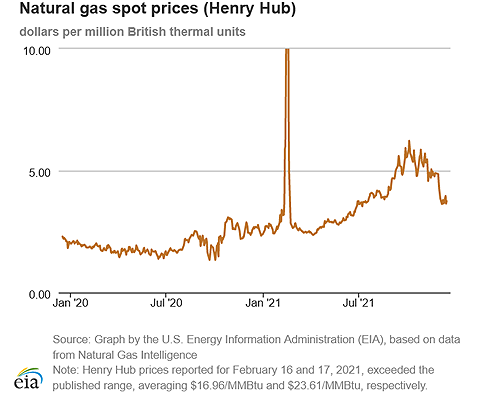
| Spot Prices ($/MMBtu) | Thu, 09-Dec |
Fri, 10-Dec |
Mon, 13-Dec |
Tue, 14-Dec |
Wed, 15-Dec |
|---|---|---|---|---|---|
| Henry Hub |
3.66 |
3.67 |
3.96 |
3.65 |
3.75 |
| New York |
3.18 |
2.95 |
3.43 |
2.99 |
3.00 |
| Chicago |
3.46 |
3.57 |
3.90 |
3.39 |
3.59 |
| Cal. Comp. Avg.* |
5.21 |
4.79 |
5.96 |
5.48 |
5.26 |
| Futures ($/MMBtu) | |||||
| January contract | 3.814 |
3.925 |
3.794 |
3.747 |
3.802 |
| February contract |
3.784 |
3.889 |
3.761 |
3.713 |
3.761 |
| *Avg. of NGI's reported prices for: Malin, PG&E Citygate, and Southern California Border Avg. | |||||
| Source: NGI's Daily Gas Price Index | |||||
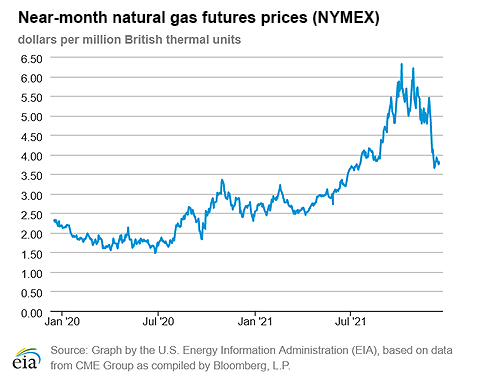
| U.S. natural gas supply - Gas Week: (12/9/21 - 12/15/21) | |||
|---|---|---|---|
Average daily values (billion cubic feet) |
|||
this week |
last week |
last year |
|
| Marketed production | 107.9 |
107.4 |
102.3 |
| Dry production | 95.9 |
95.4 |
90.6 |
| Net Canada imports | 4.8 |
4.8 |
5.1 |
| LNG pipeline deliveries | 0.1 |
0.1 |
0.1 |
| Total supply | 100.8 |
100.4 |
95.9 |
|
Source: Chart by the U.S. Energy Information Administration (EIA), based on data from IHS Markit | |||
| U.S. natural gas consumption - Gas Week: (12/9/21 - 12/15/21) | |||
|---|---|---|---|
Average daily values (billion cubic feet) |
|||
this week |
last week |
last year |
|
| U.S. consumption | 85.0 |
86.2 |
88.3 |
| Power | 28.7 |
28.7 |
27.6 |
| Industrial | 23.6 |
23.9 |
24.7 |
| Residential/commercial | 32.6 |
33.6 |
36.0 |
| Mexico exports | 5.1 |
5.3 |
5.6 |
| Pipeline fuel use/losses | 7.0 |
7.0 |
6.8 |
| LNG pipeline receipts | 11.8 |
11.9 |
11.4 |
| Total demand | 108.8 |
110.4 |
112.1 |
|
Source: Chart by the U.S. Energy Information Administration (EIA), based on data from IHS Markit | |||
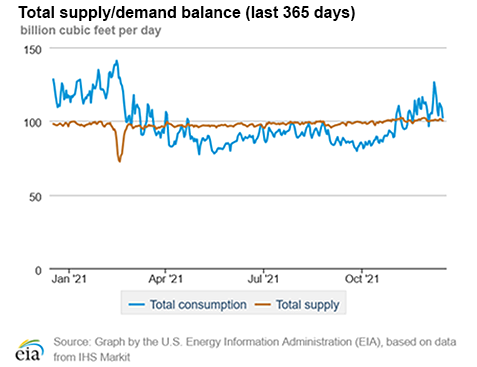
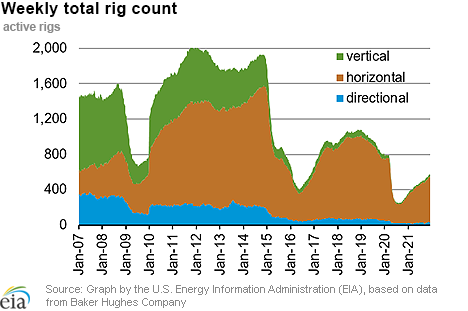
| Rigs | |||
|---|---|---|---|
Tue, December 07, 2021 |
Change from |
||
last week |
last year |
||
| Oil rigs | 471 |
0.9% |
82.6% |
| Natural gas rigs | 105 |
2.9% |
32.9% |
| Note: Excludes any miscellaneous rigs | |||
| Rig numbers by type | |||
|---|---|---|---|
Tue, December 07, 2021 |
Change from |
||
last week |
last year |
||
| Vertical | 24 |
-4.0% |
60.0% |
| Horizontal | 521 |
1.6% |
70.3% |
| Directional | 31 |
0.0% |
82.4% |
| Source: Chart by the U.S. Energy Information Administration (EIA), based on data from Baker Hughes Company | |||
| Working gas in underground storage | ||||
|---|---|---|---|---|
Stocks billion cubic feet (Bcf) |
||||
| Region | 2021-12-10 |
2021-12-03 |
change |
|
| East | 818 |
843 |
-25 |
|
| Midwest | 982 |
1,019 |
-37 |
|
| Mountain | 199 |
206 |
-7 |
|
| Pacific | 261 |
266 |
-5 |
|
| South Central | 1,158 |
1,171 |
-13 |
|
| Total | 3,417 |
3,505 |
-88 |
|
|
Source: U.S. Energy Information Administration Form EIA-912, Weekly Underground Natural Gas Storage Report | ||||
| Working gas in underground storage | |||||
|---|---|---|---|---|---|
Historical comparisons |
|||||
Year ago (12/10/20) |
5-year average (2016-2020) |
||||
| Region | Stocks (Bcf) |
% change |
Stocks (Bcf) |
% change |
|
| East | 886 |
-7.7 |
830 |
-1.4 |
|
| Midwest | 1,064 |
-7.7 |
1,000 |
-1.8 |
|
| Mountain | 224 |
-11.2 |
205 |
-2.9 |
|
| Pacific | 307 |
-15.0 |
285 |
-8.4 |
|
| South Central | 1,261 |
-8.2 |
1,160 |
-0.2 |
|
| Total | 3,743 |
-8.7 |
3,481 |
-1.8 |
|
| Source: U.S. Energy Information Administration Form EIA-912, Weekly Underground Natural Gas Storage Report | |||||
| Temperature – heating & cooling degree days (week ending Dec 09) | ||||||||
|---|---|---|---|---|---|---|---|---|
HDDs |
CDDs |
|||||||
| Region | Current total |
Deviation from normal |
Deviation from last year |
Current total |
Deviation from normal |
Deviation from last year |
||
| New England | 203 |
-11 |
5 |
0 |
0 |
0 |
||
| Middle Atlantic | 189 |
-15 |
-10 |
0 |
0 |
0 |
||
| E N Central | 220 |
-13 |
-1 |
0 |
0 |
0 |
||
| W N Central | 221 |
-38 |
8 |
0 |
0 |
0 |
||
| South Atlantic | 115 |
-27 |
-42 |
10 |
1 |
6 |
||
| E S Central | 102 |
-44 |
-72 |
0 |
-1 |
0 |
||
| W S Central | 51 |
-57 |
-71 |
16 |
13 |
16 |
||
| Mountain | 164 |
-51 |
-37 |
0 |
0 |
0 |
||
| Pacific | 100 |
-14 |
13 |
0 |
-1 |
0 |
||
| United States | 157 |
-26 |
-16 |
4 |
2 |
3 |
||
|
Source: Chart by the U.S. Energy Information Administration (EIA), based on data from the National Oceanic and Atmospheric Administration Note: HDDs=heating degree days; CDDs=cooling degree days | ||||||||
Average temperature (°F)
7-day mean ending Dec 09, 2021
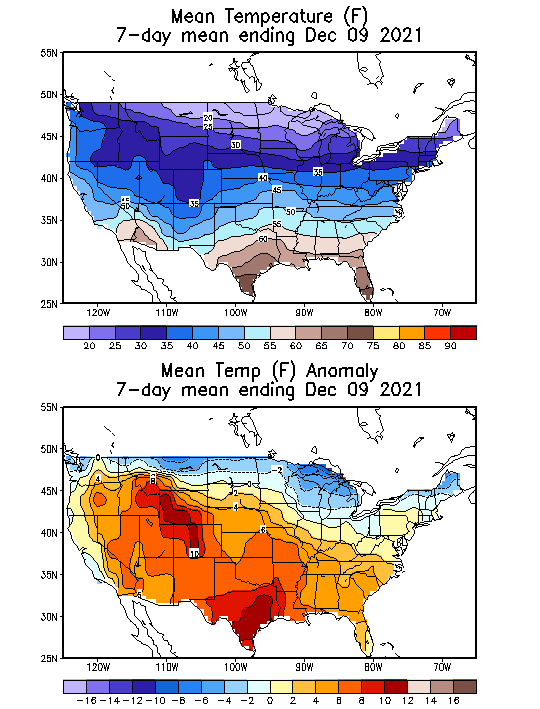
Source: National Oceanic and Atmospheric Administration
Deviation between average and normal (°F)
7-day mean ending Dec 09, 2021

Source: National Oceanic and Atmospheric Administration

